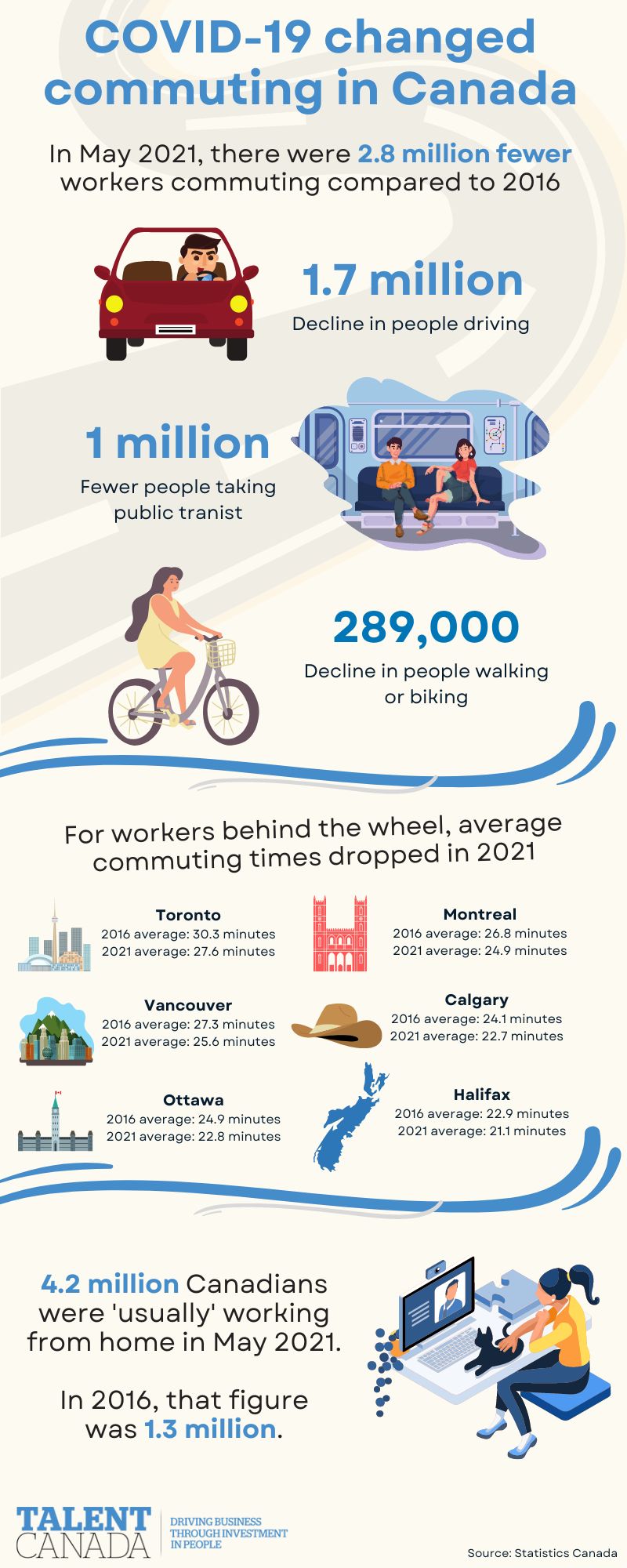

Features
Workforce Statistics
Working Remotely
Canadians hit the brakes on commuting to work in 2021: Statistics Canada
November 30, 2022
By
Talent Canada
 The opportunity to work remotely during the pandemic has many considering escaping commutes such as Toronto's 401 highway. (Talent Canada)
The opportunity to work remotely during the pandemic has many considering escaping commutes such as Toronto's 401 highway. (Talent Canada) The full impact of the pandemic on commuting patterns and working from home is coming into focus, thanks to new data from Statistics Canada.
There were 2.8 million fewer Canadians commuting to work in May 2021, it said. And the number of people working remotely swelled by about 225 per cent compared to 2016.
The numbers show the full impact of the pandemic on commuting patterns, with all forms of transportation seeing a drop. The data showed:
- 1.7 million fewer people travelling to work by car
- about one million fewer people taking public transit (the first-ever reported decline in this statistic)
- 289,000 less people walking or cycling to work.
Statistics Canada said the decline in commuting was the result of two primary factors. First, the COVID-19 pandemic resulted in unprecedented employment losses — especially among businesses that required close physical contact indoors, including restaurants, retailers and gyms.
Second, there was a huge shift in working from home in industries where it was possible. In May 2021, there were 4.2 million people usually working at home, more than three times the level seen in May 2016 when it was 1.3 million.
“Increases in working from home were concentrated in industries such as professional, scientific and technical services; public administration; finance and insurance; and educational services,” according to Statistics Canada.
Noticeable drop in driving times
The data showed that, for those behind the wheel in May 2021, the drive was quite a bit shorter than usual. On average, it took drivers 22.8 minutes to get to work in May 2021. That’s down from 24.1 minutes in May 2016.
Toronto drivers saw the biggest benefit with less traffic, as average drives drop 2.7 minutes. Other municipalities in the GTA also enjoyed higher than average drops in drive time, including Hamilton and Oshawa (down 2.2 minutes each). Ottawa and St. John’s, N.L., reported shorter drives on average by 2.1 minutes.
And the number of Canadians making long commutes by car also plunged. The number of people spending more than one hour in their cars fell by 28.7 per cent compared to 2016.
Moving cities
Not only were Canadians working remotely, but they were also moving their residence.
“In other words, virtual work not only affects where people work and whether they commute, but can also influence where they choose to live and how they get to work,” it said. “Whether this phenomenon will continue remains to be seen.”
Canadians back in cars, but resisting public transit
By the spring of 2022, there were signs that commuting – at least by car – was returning to pre-pandemic pattens. With most public health measures removed by the spring of 2022, data showed the number of car commuters was 12.8 million, “about the same as in 2016.”
The data for public transit, though, told a different story. In May 2022, there were 1.2 million people commuting by public transit, well behind the pre-pandemic levels of two million from May 2016.
The agency said it is “too soon” to tell if the impact on public transit is temporary or lasting, but the May 2021 data will provide a baseline from which to gauge ridership going forward.
The ridership drop was spread across all modes of public transit:
- Commuting by bus was down 42.8 per cent
- Commuting by subway was down 54.6 per cent
- Commuting by light rail, train and streetcar was down 68.5 per cent
Infographic: How the pandemic changed commuting
Print this page
